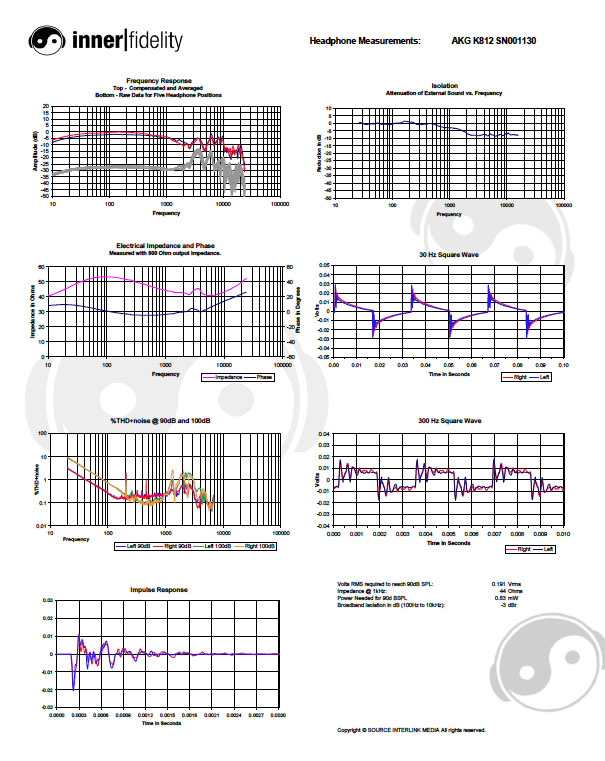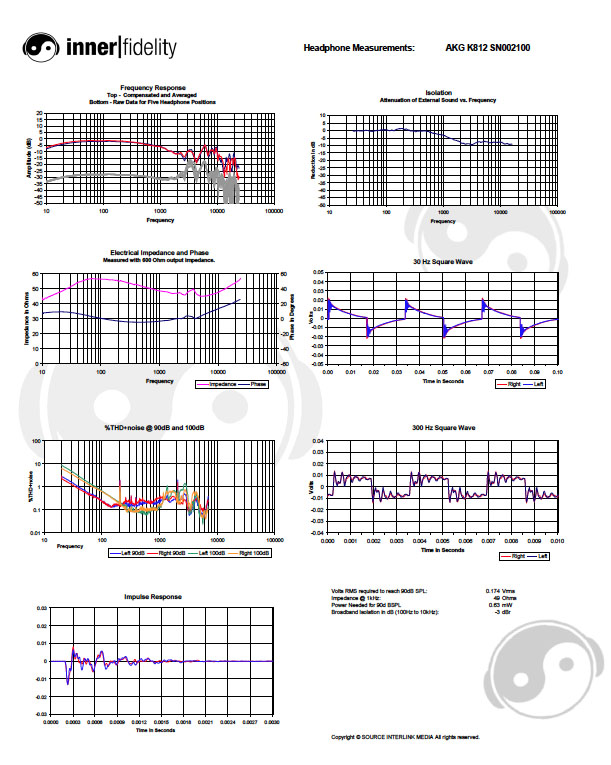| Columns Retired Columns & Blogs |
The AKG K812 Professional Reference Headphone Measurements
Measurements AKG K812 SN001130

Click on graphs image to download .pdf for closer inspection.
Measurements AKG K812 SN002100

Click on graphs image to download .pdf for closer inspection.
I have had the chance to measure two samples of this headphone; both sets of measurements are displayed above. Both headphones measured quite similarly—two is a small sample, but it does seem evident that these measurements reflect the performance of the headphones well. In other words, I don't think I just happened to get a bad one the first time around.
Raw frequency response plots indicate performance is very stable with movements of the headphones on the head. Compensated response from 10Hz to 2kHz shows a very broad and mild humped response. While I'd like to see some bass boost of about 5dB below 120Hz as specified by the Harman target response curve, these cans do a very good job of maintaining a smooth flat response curve. I don't think I've seen anything any better from a traditional dynamic driver headphone. Response above 2kHz is worryingly filled with numerous peaks. While the overall profile is fairly good, there is simply too much noise. Response between 10kHz and 20kHz looks a tad hot to me, I'd prefer to see a gentle slope downward rather than a flat response in this area.
I'll take a moment here to focus in on the peak at 3kHz. You'll notice there is a corresponding bump in the impedance plot, and an elevated THD+noise hump just below this frequency. These types of artifacts are sometimes cause by acoustic problems around the driver. My guess would be that we're seeing some uncontrolled modal break-up of the diaphragm...but that's just a guess.
Other than the noisy leading edge, the 30Hz square wave has good shape for a traditional open dynamic driver headphone. The 300Hz square wave gives us a closer look at the leading edge noise; while the initial edge is fast and clean, the following noise is quite excessive. Impulse response is likewise overly noisy with artifacts.
Frequency response above 3kHz, the impedance blip at 3kHz, the distortion between 1kHz and 3kHz, and the noise subsequent to transients are pretty bad, and seem to me to be directly related to the problems I heard in the treble of these cans during listening tests.
The rising bass distortion below about 150Hz is fairly common in open dynamic headphones. I'd say the measured distortion here a bit worse than average. The AKG K712, for example, performs better in this regard...well, in most other regards as well. However in listening tests, though the bass wasn't as tight as the LCD-X, it did seem quite a bit better than what I see in the measurements.
Isolation is minimal, as it should be in an open headphone.
Impedance plot shows these as having a primary driver resonance at 100Hz where impedance peaks at 55 Ohms. This is 44 Ohm headphone on average. Needing 191mVrms to achieve 90dBspl in the headphones these won't play loud on your portable player, but it will be able to play to satisfactory levels where many high-end competing cans won't.
- Log in or register to post comments




































